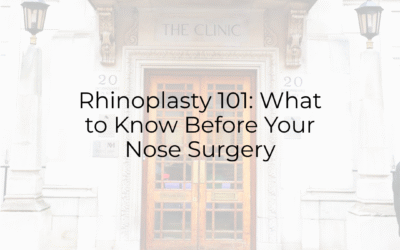The nose is a central feature of the face, and for many people, its appearance and function are deeply connected to their self-confidence and quality of life. Whether you’re considering a change for cosmetic reasons, to improve breathing, or to correct a past issue, the world of nasal surgery is more advanced than ever. Understanding the different types of nose jobs, or rhinoplasty procedures, is the first step toward making an informed decision.
This guide will walk you through seven distinct types of nasal surgery. We’ll explore what each procedure entails, who it’s best suited for, and the unique benefits it offers. From subtle refinements to complex reconstructions, there’s a specialized approach for nearly every goal.
Preservation Rhinoplasty
Preservation rhinoplasty is a modern surgical technique that focuses on reshaping the nose by preserving, rather than removing, its natural bone and cartilage structures. Traditional methods often involve breaking and removing tissue to alter the nose’s shape, which can sometimes lead to instability over time. This approach takes a different route.
Instead of removing a “hump” from the top of the nasal bridge, the surgeon removes tissue from underneath, allowing the bridge to drop down into a new, lower position. This maintains the smooth, natural dorsal line of the nose. It’s an ideal option for individuals seeking to reduce a dorsal hump without drastically changing their nasal character.
Who is it for?
This procedure is best for patients who need adjustments to the nasal bridge but have good tip structure and symmetry. It’s often preferred by those looking for a less invasive option with a potentially faster recovery and more natural-looking results.
Ethnic Rhinoplasty
Ethnic rhinoplasty is a highly specialized field of cosmetic surgery that aims to enhance the nose while honoring and preserving the patient’s unique ethnic features. Surgeons performing this procedure require a deep understanding of the diverse anatomical characteristics of noses from different backgrounds, whether African, Asian, Hispanic, or Middle Eastern.
The goal is not to create a generic, “Westernized” nose. Instead, the focus is on achieving facial harmony by making subtle refinements that complement the patient’s natural beauty. This might involve augmenting a flat nasal bridge, refining a wide tip, or narrowing nostrils, all while ensuring the result looks balanced and authentic.
Who is it for?
This surgery is for individuals of non-Caucasian descent who wish to alter the appearance of their nose but want to maintain their ethnic identity. It requires a surgeon with extensive experience and artistic sensitivity to different facial anatomies.
Revision Rhinoplasty
Revision rhinoplasty, also known as secondary or tertiary rhinoplasty, is a procedure performed to correct or improve the results of a previous nose surgery. Patients may seek a revision for various reasons, including dissatisfaction with the cosmetic outcome, breathing difficulties that developed after the initial surgery, or structural issues like a collapsed nasal valve.
These procedures are often more complex than primary rhinoplasties. The surgeon must work with scar tissue and altered anatomy, which can make the surgery more challenging and unpredictable. In many cases, cartilage grafts from the ear, rib, or a donor may be needed to rebuild the nasal structure.
Who is it for?
Anyone who is unhappy with the functional or aesthetic outcome of a previous nose job is a potential candidate. It is crucial to choose a highly skilled surgeon who specializes in revision procedures, as they possess the expertise to navigate these complex cases.
Cleft Rhinoplasty
Cleft rhinoplasty is a reconstructive procedure designed to correct nasal deformities associated with a cleft lip and palate. A cleft is a birth defect that occurs when a baby’s lip or mouth does not form completely during pregnancy. This often results in significant asymmetry and structural abnormalities in the nose, affecting both its appearance and function.
The surgery aims to create a more symmetrical and functional nose. This typically involves straightening the septum, reshaping the nasal tip, and creating more balanced nostrils. Cleft rhinoplasty can be a multi-stage process, sometimes starting in childhood and continuing into the teenage years as the face develops.
Who is it for?
This procedure is for individuals born with a cleft lip and/or palate. It is a vital part of the comprehensive treatment plan to restore normal facial structure and improve breathing.
Septoplasty
Unlike the other procedures on this list, a septoplasty is performed primarily for functional, not cosmetic, reasons. The septum is the wall of bone and cartilage that divides your nostrils. When it’s crooked or off-center, it’s called a deviated septum, a condition that can obstruct airflow and cause significant breathing problems.
During a septoplasty, a surgeon straightens the deviated septum to improve airflow. The procedure is performed entirely inside the nose, so there are no external incisions or visible scarring. While the main goal is to improve breathing, it does not change the external appearance of the nose.
Who is it for?
This surgery is for anyone diagnosed with a deviated septum that causes chronic nasal congestion, difficulty breathing, snoring, or recurrent sinus infections.
Septorhinoplasty
A septorhinoplasty combines two procedures into one: a septoplasty and a rhinoplasty. This integrated surgery addresses both the function and the appearance of the nose at the same time. It’s an efficient approach for patients who have a deviated septum and also wish to make cosmetic changes to their nose.
By performing both surgeries together, the surgeon can use cartilage removed while straightening the septum to help reshape and support the nose cosmetically. This can lead to a more stable and aesthetically pleasing long-term result, along with improved breathing.
Who is it for?
This is the ideal procedure for individuals who struggle with breathing due to a deviated septum and are also unhappy with the external shape or size of their nose.
Ultrasonic Rhinoplasty
Ultrasonic, or piezo, rhinoplasty is an advanced technique that uses a specialized tool that generates high-speed sound waves to precisely sculpt nasal bones. Traditional instruments like hammers and chisels can cause more trauma to surrounding soft tissues. The ultrasonic device, however, allows the surgeon to shave and cut bone with incredible accuracy without damaging nearby cartilage, mucosa, and skin.
This precision results in less bruising, swelling, and pain for the patient, often leading to a quicker and more comfortable recovery. It gives the surgeon greater control when refining the nasal bones, allowing for smoother and more predictable outcomes.
Who is it for?
This technique is particularly useful for patients who require detailed work on the nasal bones, such as reducing a large dorsal hump or narrowing the nasal bridge. It’s an excellent option for those seeking a more refined result with the benefit of a gentler recovery.
Choosing the Right Path
Selecting the right type of nose surgery depends entirely on your individual anatomy and personal goals. Whether your aim is to breathe easier, refine your appearance, or correct a past procedure, book a consultation to for a clear outcome of that is best for you. We can help you navigate these options and create a personalised plan to achieve the results you desire.



